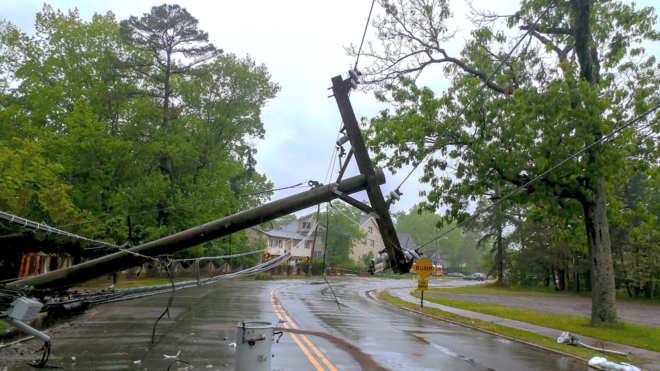Enhancing Storm Preparedness and Response with Smart Infrastructure

By Dave Herlong
Ubicquia Chief Operating Officer
As professionals in the utility business, we have witnessed severe storms wreaking havoc on our grid infrastructure this year, and we’re only at the beginning of hurricane season. The National Oceanic and Atmospheric Administration (NOAA) has predicted an exceptionally active Atlantic hurricane season for 2024, and we’ve already experienced the destructive force of storms like Beryl and Debby across parts of Texas, the Caribbean, and the Southeast U.S. with restoration efforts only now being completed. The toll on lives and property is devastating, with tropical storms and hurricanes claiming at least 87 lives and causing over $8.9 billion in damages so far this season.
Restoring Electricity: A Vital Part of Storm Recovery
Rapid restoration of electricity is crucial to community safety and the return of normalcy after a storm. Effective recovery hinges on meticulous planning and preparation.
With nearly 30 years of experience in the industry, I’ve learned the critical importance of preparedness, particularly the three Rs of storm readiness: Reliability, Resiliency, and Recovery. Each of these elements works in a virtuous circle. Enhancing grid reliability enables resiliency for faster community recovery from storm damage, making recovery efforts more efficient and providing valuable insights to strengthen vulnerable grid components and begin the circle again for improved reliability and resiliency.
Improving Reliability
Reliability is about ensuring that the grid delivers safe, dependable, and affordable electricity daily. The electric grid, often referred to as the world’s largest machine, is an aging and complex network facing more demands than ever before. Aging infrastructure and vegetation encroachment increase grid vulnerability during a storm, and skyrocketing demand for electrification and distributed energy resources make storms even more devastating.
Strengthening the grid’s most susceptible components is essential to withstand and recover from severe storms. Like maintaining health to avoid illness or recover quickly, locating and addressing vulnerable grid elements is critical for storm readiness. Identifying issues such as failing equipment, loose connections, encroaching vegetation, or tilting poles is vital. Additionally, it’s crucial to:
- Identify primary circuits (feeders) serving priority customers like hospitals, public safety, and emergency operation centers.
- Strengthen and upgrade grid elements along those feeders.
- Implement response and restoration plans for these critical customers.
Hardening vulnerable grid elements
Utilities have heavily invested in grid hardening, yet certain areas, especially the distribution infrastructure where 92% of outages occur, remain vulnerable. This "last mile" of the grid is often invisible. While substations and smart meters are connected, critical components like distribution transformers remain unconnected and invisible.
Intelligent, connected transformers provide visibility into their health, age, and performance, allowing us to anticipate unexpected failures during routine operations and severe weather. Replacing a failing transformer during a planned outage is much more efficient and cost-effective than during a storm when time is of the essence.
Utility poles are also vulnerable to vegetation encroachment and flying debris. Damaged and down poles have the most significant impact on customers and take the longest to restore. Monitoring the condition and stability of utility poles and streetlights is crucial for reliability and storm readiness. Traditional pole inspections are cyclical and costly and often miss at-risk pole conditions. Restoration efforts could be more efficient and cost-effective with real-time monitoring of poles and streetlights during daily operations and storms.
Resiliency – Bouncing Back
A storm is the ultimate test of grid reliability and preparedness, where visibility is paramount. Even the most resilient grids face inevitable damage during severe weather. Traditionally, restoration begins only after time-consuming physical inspections determine the extent of the damage. However, leveraging real-time storm damage reports generated from data collected during the event would significantly enhance visibility and quickly identify the areas of most significant impact.
Ideally, we would replace physical post-storm inspections with real-time situational awareness of outages, damaged equipment, and leaning or downed poles during the storm. This would enable us to dispatch the right crews and equipment to the right locations, significantly reducing restoration time and costs. Imagine the savings during a major event if mutual aid crews could be quickly and accurately deployed instead of waiting for assignments.
Recovery and Lessons Learned
Once the grid is reenergized, the recovery phase focuses on making permanent repairs, stabilizing the system, and addressing the vulnerable areas identified earlier. Smart streetlights and intelligent last-mile infrastructure can pinpoint the location of damaged or downed streetlights and poles, making the recovery process safer, more efficient, and cost-effective. Rapid restoration of streetlights serves as a visible indicator of recovery for communities affected by the storm.
Recovery is also an opportunity to assess planning, prioritization, and the grid's overall health. Accurate information is needed to analyze grid performance during the storm, identify and locate vulnerabilities, and make necessary investments to enhance grid reliability and resiliency.
Digitization and Analytics that Matter
I’ve described ideal scenarios where timely information about grid health and damage is available in real-time before, during, and after a storm. The digitization of the grid, supported by advanced sensor technology, machine learning, and data science, is making these scenarios increasingly possible.
At Ubicquia, we're driven by the transformative power of digitization, which significantly boosts reliability and resilience. By enabling utilities to measure what truly matters, we help ensure the consistent delivery of safe, dependable, and affordable electricity.
We provide advanced sensor technologies, analytics, and actionable insights to manage streetlights with our UbiCell smart lighting control platform and monitor distribution transformers with our UbiGrid Distribution Transformer Monitor. These advanced sensors feed timely data into our UbiVu Intelligent Asset Management system, using AI models to provide analytics that matter for improved storm response, asset management, power quality, and reliability.
For customers with these technologies, we’ve developed a set of actionable insights, and storm reports that provide accurate and timely in-storm visibility of damage and outages. These reports combine sensor data with geolocation to map power loss events, pinpoint energized and de-energized poles, rank feeders by power loss events, and even rank power loss by county.
These reports are just one of the many capabilities we offer using data-driven insights from our sensors to deliver exception-based alerting and trends that enable utilities to improve reliability, address vulnerabilities, reduce operational expenses, and increase crew efficiency by minimizing time spent on cyclical tasks.
Just Scratching the Surface
We are only beginning to explore the range of analytics capabilities that machine learning can unlock when combined with sensor data and other data sources, such as weather, GIS, and satellite imaging. This is promising news for grid operators.
By closing the visibility gap in distribution infrastructure, utilities can gain a comprehensive view across the entire grid. Distribution transformers offer a wealth of data on grid health and power quality, which can be analyzed and turned into actionable insights, enabling operators to make more informed decisions and act swiftly.
Actionable analytics can predict outages not just hours or days in advance but weeks ahead. Imagine integrating precipitation, wind, and GIS data to refine vegetation management and precisely identify problem areas, including storm and wildfire risks. Consider advanced fault detection, where clustered transformer sag alerts and geolocation data are triangulated to identify ground faults swiftly.
Investing for the Future
While we can’t control the weather, continued investment in grid digitization and fortifying vulnerable segments like the distribution infrastructure will significantly enhance reliability and resilience. These efforts not only ensure smoother daily operations but also enable quicker recovery from inevitable storms. The return on these investments extends far beyond the balance sheet—it’s about safeguarding our communities and keeping our businesses running, fulfilling our commitment to delivering safe, dependable, and affordable electricity.

